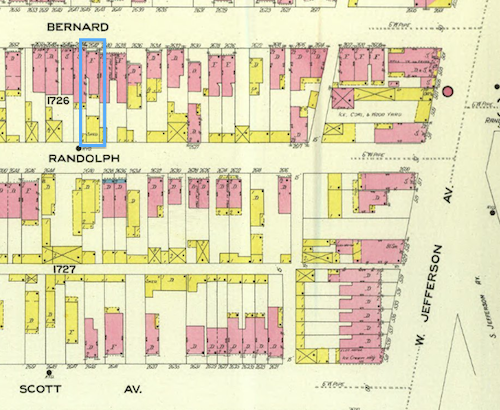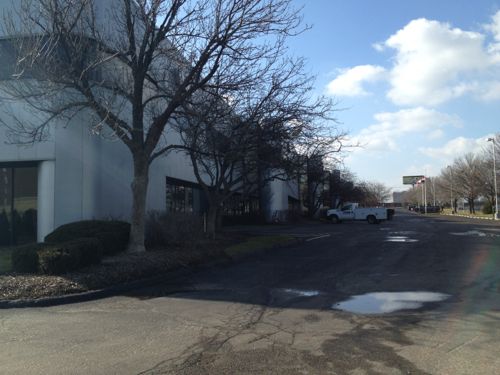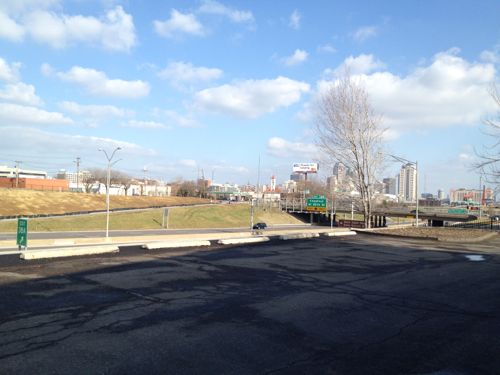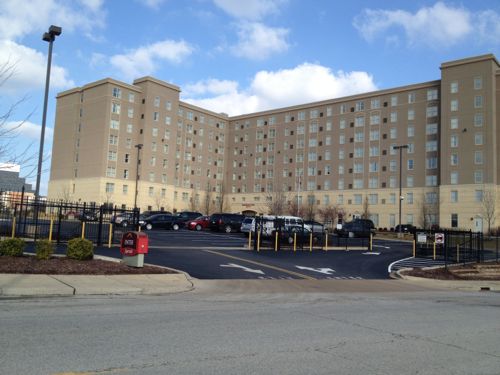Where Josephine Baker Grew Up
I love the Post-Dispatch’s “A Look Back” series of photographs and articles. I eagerly read the recent story on St. Louis native Josephine Baker (1906-1975) and one sentence stood out:
“She told the Post-Dispatch in 1950 that she began dancing for friends in her home at 2632 Bernard Street, in an area obliterated for Highway 40.” (STLtoday.com)
Anytime I see an address my instinct is to look it up on Google Maps, but it was “obliterated for Highway 40.” Â So I went to the University of Missouri’s Digital Library to look it up on the Sanborn Fire Insurance Co maps in their collection.

Jefferson Ave & Scott Ave both still exist (map) but Randolph & Bernard are no longer part of the street grid. But looking at the map it wasn’t clear her house and neighborhood were razed for the highway, it looked just south of the highway.
Next I went to HistoricAerials.com to try to find an aerial photograph prior to demolition. The oldest photo they have for St. Louis is 1958 so I wasn’t certain. But prior to 1967 the expressways from the west merged onto eastbound Market Street near Compton Ave. Sure enough her flat was just south of the highway right-of-way. Like streets next to I-44, Bernard would have only had houses remaining on the south with the north part of the highway. But Baker’s childhood flat was on the south, not the north.  Thus, her flat wasn’t “obliterated for Highway 40” as the Post-Dispatch wrote.
In the 1971 image for the same location looks like

City records show the four buildings of the St. Louis Business Center were built in 1986 — at least 15 years after the area was razed.

Baker’s flat was probably about on the dividing line between the 80s business center and what’s now a Marriott hotel, built in 2004.

Before the Marriott, a Napa auto parts warehouse was located on this site.
So now I’m curious to find out just when the houses on these blocks were razed. Baker was already world famous when the wrecking ball destroyed where she lived.  Did anyone suggest saving her flat as a historic site?  Were St. Louisans upset Baker refused to perform in St. Louis prior to 1952 because she wouldn’t perform for segregated  audiences?
– Steve Patterson
On the continuum of important people, most dancers, even “world famous” ones, don’t rank that highly. Combine that with the fact that she wasn’t the first or only “famous” person to come from St. Louis and I’m not surprised that there was no groundswell of support to save her childhood home. Bigger picture is the whole question of why we would want to “save” most people’s childhood homes or birthplaces, at all? Yes, it was an old structure, and yes, it had “history”, but why make it a museum? Graceland (Elvis Presley’s home in Memphis) continues to attract visitors, but these are, for the most part, people that still remember his live performances. Who were the great performers of the 1920’s? Of the 1880’s? Do we even care? And on a more contemporary level, do we care where Steve Jobs or Bill Gates were born or spent their childhoods? Mayor Slay or Governor Nixon? Madonna or Jon Bon Jovi? The importance of all these people is in what they’ve done, not in which house they were born. Their history will live on in books and, now, electronic media, and their contributions will be most appreciated in context, on the walls of City Hall, in the Smithsonian and at the Rock and Roll Hall of Fame. Or, to look at it another way, should we be saving Chuck Berry’s local childhood home? Stan Musial’s That stooge of Three Stooges fame? Buzz Westphal’s? Life moves on – we can’t save everything . . . .
On the continuum of important people, most dancers, even “world famous” ones, don’t rank that highly. Combine that with the fact that she wasn’t the first or only “famous” person to come from St. Louis and I’m not surprised that there was no groundswell of support to save her childhood home. Bigger picture is the whole question of why we would want to “save” most people’s childhood homes or birthplaces, at all? Yes, it was an old structure, and yes, it had “history”, but why make it a museum? Graceland (Elvis Presley’s home in Memphis) continues to attract visitors, but these are, for the most part, people that still remember his live performances. Who were the great performers of the 1920’s? Of the 1880’s? Do we even care? And on a more contemporary level, do we care where Steve Jobs or Bill Gates were born or spent their childhoods? Mayor Slay or Governor Nixon? Madonna or Jon Bon Jovi? The importance of all these people is in what they’ve done, not in which house they were born. Their history will live on in books and, now, electronic media, and their contributions will be most appreciated in context, on the walls of City Hall, in the Smithsonian and at the Rock and Roll Hall of Fame. Or, to look at it another way, should we be saving Chuck Berry’s local childhood home? Stan Musial’s? That stooge of Three Stooges fame? Buzz Westphal’s? Life moves on – we can’t save everything . . . .
Yer turning into a real crank, Jim.
Frankly, Jim, I do care about performers from the 20’s and 30’s: Bix Biederbeck, Louie Armstrong, Bessie Smith, Henry Townsend, Artie Shaw. These people are important not only because they are a major part of history, but because of the contributions they made to human culture. And Josephine Baker is one of those great people, not only for the fact that she was a celebrated entertainer, but because of her lifelong humanitarian and philanthropic efforts on the behalf of children, including the 50 or so she adopted herself.
The spiral of American culture and human society into oblivion continues apace…
You’re right, it does sound cranky, so let me clarify. I like history and I truly appreciate these nuggets that Steve researches and publicizes. I like a lot of museums, especially those that clarify specific events (the National Civil Rights Museum in Memphis and the Texas Schoolbook Depository in Dallas are two outstanding ones) or are just quirky (the City Museum and the recently-closed Radio Museum on Cherokee Street are two local ones). I have less appreciation of trying to make anything touched by a famous person (more) important, especially if the context has disappeared. What shaped Josephine Baker (or anyone else) was not the individual residential structure, it was the entire neighborhood. Unless we’re going to (successfully) save and freeze multiple blocks, just saving one random house and filling it with dusty artifacts serves little to either educate the public or to improve a struggling neighborhood.
Should Josephine Baker be remembered and honored? Absolutely. Would this be a great location to do so? Probably not. Wikipedia notes that her sons are already doing so in New York. I’m pretty sure that she has a star on the walk of fame in the Delmar Loop. She deserves a spot in the Missouri History Museum, if she doesn’t already have one. She’s on Wikipedia and in history books. I just see little purpose, in response to Steve’s question, in “saving her flat as a historic site” in the middle of an industrial park. At best, she deserves one of those historic markers here, “On this site . . . .” If we want to make the world aware of how wonderful she was, there are better places than a Marriott parking lot!
Also, given the particulars of her profession I doubt city leaders would have been rushing to preserve her childhood home, especially a couple decades before the HBO series.
She was born at the hospital that was at where sublette park is now. It was a hospital for prostitutes and “women in trouble.” The area directly to the west and south of there were the “poor houses.”
Baker described herself as a street child in the slums of St. Louis who regularly scavenged food from the garbage. She was the illegitimate daughter of an unidentified white man and a mother who grew up as the adopted daughter of former slaves in Arkansas.
Given what I know of St. Louis and their social class, I just can’t imagine that Bernard street looked like something worth preserving back then.
(above)Said the man with skewed historical insight. Your argument is not very cogent when you compare Buzz Westphal and Mayor Slay to the importance of Josephine Baker. She was a pioneer in her field, her importance greatly recognized in Europe (mostly)…and that might be the problem, but just like if we would recognize most of the BLUES were actually started here and not in Memphis we would also realize we COULD lure European tourist to come here to see her house. There have been many a summer in St. Louis where I have run into European tourists that want to see stuff related to Chuck Berry, Scott Joplin and Gaslight Square, just becuase you don’t understand the importance doesn’t mean it isn’t important. (and saving EVERY old building was not mentioned in this conversation).
(above)Said the man with skewed historical insight. Your argument is not very cogent when you compare Buzz Westphal and Mayor Slay to the importance of Josephine Baker. She was a pioneer in her field, her importance greatly recognized in Europe (mostly)…and that might be the problem, but just like if we would recognize most of the BLUES were actually started here and not in Memphis we would also realize we COULD lure European tourist to come here to see her house. There have been many a summer in St. Louis where I have run into European tourists that want to see stuff related to Chuck Berry, Scott Joplin and Gaslight Square, just becuase you don’t understand the importance doesn’t mean it isn’t important. (and saving EVERY old building was not mentioned in this conversation).
And that’s my point, history depends on one’s perspective, especially when it involves the performing arts. I don’t doubt that Ms. Baker made important contributions in her chosen field, I just question how important preserving her childhood home would have been. She was born here 106 years, left St. Louis when she was 16 (90 years ago), and died 32 years ago. Even if her childhood home was demolished circa 1970, that would still be 50 years after she abandoned the city and 5 years before she passed away (an event that usually generates efforts to preserve a person’s legacy).
Should we be acting, now, to save Nelly’s boyhood home? And once it’s been “saved”, then what? The typical answer is to make it into a museum. Museums that focus on a single individual tend to have attendance that mirrors the direct connection people feel for the performer. Elvis was born 77 years ago and died 25 years ago. He still has many fans, and they continue to vist his home / museum. Glenn Miller was born 108 years ago and died 68 years ago, and was probably as big star to his generation as Elvis was to the next. His hometown, Clarinda, Iowa, has a museum dedicated to his life and works, adjacent to his boyhood home. I have no idea what their attendance figures are like, but they’re undoubtedly much smaller than Graceland’s (and in 30 years, Graceland will be struggling to remain relevent).
I know where the Scott Joplin House / Museum and the Eugene Field Hause are. I’ve lived here for nearly 8 years. I have yet to think about visiting either one (as have many other locals). And in researching this response, I find that the Joplin House is not his boyhood home (he’s wasn’t even born here), it’s one that he acquired 16 years before he died! Bottom line, I don’t have a problem remembering what people have done, I just see little point in tying it to a person’s childhood home. Growing up in Kentucky, my parents dragged me to Lincoln’s boyhood home and to multiple Victorian homes / museums filled with dusty exhibits. If Ms. Baker’s childhood home had been saved (and she hadn’t renounced her American citizenship), then it likely would have been much like these – dull and boring.
The Scott Joplin House is a fascinating place — I highly recommend a visit. That house wasn’t his birthplace — but where he wrote some of his best known pieces.
And yes, we should be saving Chuck Berry’s home.
And yes, we should be saving Chuck Berry’s home.
Right on. Birthplaces and historic sites help form the map of a place’s culture and identity. I don’t see why the widespread recognition of this is something to argue about. Failure to make note of notable birthplaces and cultural happenings would seem to me more of a disavowal than a casual oversight. In certain locations in England, they hit you over the head with Shakespeare and PB Shelley; in Memphis and Tupelo you get Elvis-ed to death. I’m proud of the contributions St. Louis has made to art, literature, science, and popular culture. Many others are too and St. Louis should celebrate itself when it can.
Bernard still exists, though not in this immediate area.
Bernard still exists, though not in this immediate area.
Right on. Birthplaces and historic sites help form the map of a place’s culture and identity. I don’t see why the widespread recognition of this is something to argue about. Failure to make note of notable birthplaces and cultural happenings would seem to me more of a disavowal than a casual oversight. In certain locations in England, they hit you over the head with Shakespeare and PB Shelley; in Memphis and Tupelo you get Elvis-ed to death. I’m proud of the contributions St. Louis has made to art, literature, science, and popular culture. Many others are too and St. Louis should celebrate itself when it can. Â
And that’s my point, history depends on one’s perspective, especially when it involves the performing arts. I don’t doubt that Ms. Baker made important contributions in her chosen field, I just question how important preserving her childhood home would have been. She was born here 106 years, left St. Louis when she was 16 (90 years ago), and died 32 years ago. Even if her childhood home was demolished circa 1970, that would still be 50 years after she abandoned the city and 5 years before she passed away (an event that usually generates efforts to preserve a person’s legacy).
Should we be acting, now, to save Nelly’s boyhood home? And once it’s been “saved”, then what? The typical answer is to make it into a museum. Museums that focus on a single individual tend to have attendance that mirrors the direct connection people feel for the performer. Elvis was born 77 years ago and died 25 years ago. He still has many fans, and they continue to vist his home / museum. Glenn Miller was born 108 years ago and died 68 years ago, and was probably as big star to his generation as Elvis was to the next. His hometown, Clarinda, Iowa, has a museum dedicated to his life and works, adjacent to his boyhood home. I have no idea what their attendance figures are like, but they’re undoubtedly much smaller than Graceland’s (and in 30 years, Graceland will be struggling to remain relevent).
I know where the Scott Joplin House / Museum and the Eugene Field Hause are. I’ve lived here for nearly 8 years. I have yet to think about visiting either one (as have many other locals). And in researching this response, I find that the Joplin House is not his boyhood home (he’s wasn’t even born here), it’s one that he acquired 16 years before he died! Bottom line, I don’t have a problem remembering what people have done, I just see little point in tying it to a person’s childhood home. Growing up in Kentucky, my parents dragged me to Lincoln’s boyhood home and to multiple Victorian homes / museums filled with dusty exhibits. If Ms. Baker’s childhood home had been saved (and she hadn’t renounced her American citizenship), then it likely would have been much like these – dull and boring.
The Scott Joplin House is a fascinating place — I highly recommend a visit. That house wasn’t his birthplace — but where he wrote some of his best known pieces.
Yer turning into a real crank, Jim.
Frankly, Jim, I do care about performers from the 20’s and 30’s: Bix Biederbeck, Louie Armstrong, Bessie Smith, Henry Townsend, Artie Shaw. These people are important not only because they are a major part of history, but because of the contributions they made to human culture. And Josephine Baker is one of those great people, not only for the fact that she was a celebrated entertainer, but because of her lifelong humanitarian and philanthropic efforts on the behalf of children, including the 50 or so she adopted herself.
The spiral of American culture and human society into oblivion continues apace…Â
in charleston it is almost impossible to tear down any building older than 75 years. st louis would be wise to enact such a policy.
in charleston it is almost impossible to tear down any building older than 75 years. st louis would be wise to enact such a policy.
I find myself agreeing with JZ. Why not protect every structure? Why not my house? Who knows what important contributions I may make down the road? What about Steve Patterson’s? It’s all in the eye of the beholder.
And then museums cost money dear folks…yup, those good old tax dollars. I’m not sure, but everyone seems to be complaining that there aren’t enough of them. Hollywood is full of homes where those magic movie stars lived in the 20’s, 30’s, and 40’s……and you don’t hear squat about new movie stars buying them and tearing them down.  I’m just saying!
I find myself agreeing with JZ. Why not protect every structure? Why not my house? Who knows what important contributions I may make down the road? What about Steve Patterson’s? It’s all in the eye of the beholder.
And then museums cost money dear folks…yup, those good old tax dollars. I’m not sure, but everyone seems to be complaining that there aren’t enough of them. Hollywood is full of homes where those magic movie stars lived in the 20’s, 30’s, and 40’s……and you don’t hear squat about new movie stars buying them and tearing them down. I’m just saying!
Regardless of whose homes should be saved, many people find a connection when visiting these homes/museums. For example, Beatles fans visiting Paul McCartney’s or John Lennon’s boyhood homes in Liverpool feel the connection of being in a place where great songs were written back when Lennon & McCartney were unknowns like most of us. I don’t know if this adds or detracts from any of the arguments made here, but I believe it is always something to consider.
Regardless of whose homes should be saved, many people find a connection when visiting these homes/museums. For example, Beatles fans visiting Paul McCartney’s or John Lennon’s boyhood homes in Liverpool feel the connection of being in a place where great songs were written back when Lennon & McCartney were unknowns like most of us. I don’t know if this adds or detracts from any of the arguments made here, but I believe it is always something to consider.
You’re right, it does sound cranky, so let me clarify. I like history and I truly appreciate these nuggets that Steve researches and publicizes. I like a lot of museums, especially those that clarify specific events (the National Civil Rights Museum in Memphis and the Texas Schoolbook Depository in Dallas are two outstanding ones) or are just quirky (the City Museum and the recently-closed Radio Museum on Cherokee Street are two local ones). I have less appreciation of trying to make anything touched by a famous person (more) important, especially if the context has disappeared. What shaped Josephine Baker (or anyone else) was not the individual residential structure, it was the entire neighborhood. Unless we’re going to (successfully) save and freeze multiple blocks, just saving one random house and filling it with dusty artifacts serves little to either educate the public or to improve a struggling neighborhood.
Should Josephine Baker be remembered and honored? Absolutely. Would this be a great location to do so? Probably not. Wikipedia notes that her sons are already doing so in New York. I’m pretty sure that she has a star on the walk of fame in the Delmar Loop. She deserves a spot in the Missouri History Museum, if she doesn’t already have one. She’s on Wikipedia and in history books. I just see little purpose, in response to Steve’s question, in “saving her flat as a historic site” in the middle of an industrial park. At best, she deserves one of those historic markers here, “On this site . . . .” If we want to make the world aware of how wonderful she was, there are better places than a Marriott parking lot!
Also, given the particulars of her profession I doubt city leaders would have been rushing to preserve her childhood home, especially a couple decades before the HBO series.Â
She was born at the hospital that was at where sublette park is now. It was a hospital for prostitutes and “women in trouble.” The area directly to the west and south of there were the “poor houses.”Â
Baker described herself as a street child in the slums of St. Louis who regularly scavenged food from the garbage. She was the illegitimate daughter of an unidentified white man and a mother who grew up as the adopted daughter of former slaves in Arkansas.Â
Given what I know of St. Louis and their social class, I just can’t imagine that Bernard street looked like something worth preserving back then.